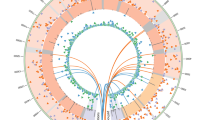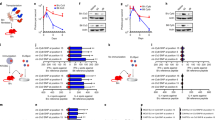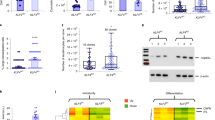Abstract
The generation of patient-specific induced pluripotent stem cells (iPSCs) offers unprecedented opportunities for modeling and treating human disease. In combination with gene therapy, the iPSC technology can be used to generate disease-free progenitor cells of potential interest for autologous cell therapy. We explain a protocol for the reproducible generation of genetically corrected iPSCs starting from the skin biopsies of Fanconi anemia patients using retroviral transduction with OCT4, SOX2 and KLF4. Before reprogramming, the fibroblasts and/or keratinocytes of the patients are genetically corrected with lentiviruses expressing FANCA. The same approach may be used for other diseases susceptible to gene therapy correction. Genetically corrected, characterized lines of patient-specific iPSCs can be obtained in 4–5 months.
This is a preview of subscription content, access via your institution
Access options
Subscribe to this journal
Receive 12 print issues and online access
$259.00 per year
only $21.58 per issue
Buy this article
- Purchase on Springer Link
- Instant access to full article PDF
Prices may be subject to local taxes which are calculated during checkout




Similar content being viewed by others
References
Takahashi, K. & Yamanaka, S. Induction of pluripotent stem cells from mouse embryonic and adult fibroblast cultures by defined factors. Cell 126, 663–676 (2006).
Takahashi, K. et al. Induction of pluripotent stem cells from adult human fibroblasts by defined factors. Cell 131, 861–872 (2007).
Yu, J. et al. Induced pluripotent stem cell lines derived from human somatic cells. Science 318, 1917–1920 (2007).
Park, I.H. et al. Reprogramming of human somatic cells to pluripotency with defined factors. Nature 451, 141–146 (2008).
Lowry, W.E. et al. Generation of human induced pluripotent stem cells from dermal fibroblasts. Proc. Nat. Acad. Sci. USA 105, 2883–2888 (2008).
Park, I.H. et al. Disease-specific induced pluripotent stem cells. Cell 134, 877–886 (2008).
Dimos, J.T. et al. Induced pluripotent stem cells generated from patients with ALS can be differentiated into motor neurons. Science 321, 1218–1221 (2008).
Ebert, A.D. et al. Induced pluripotent stem cells from a spinal muscular atrophy patient. Nature 457, 277–280 (2009).
Raya, A. et al. Disease-corrected haematopoietic progenitors from Fanconi anaemia induced pluripotent stem cells. Nature 460, 53–59 (2009).
Hong, H. et al. Suppression of induced pluripotent stem cell generation by the p53-p21 pathway. Nature 460, 1132–1135 (2009).
Kawamura, T. et al. Linking the p53 tumour suppressor pathway to somatic cell reprogramming. Nature 460, 1140–1144 (2009).
Marion, R.M. et al. A p53-mediated DNA damage response limits reprogramming to ensure iPS cell genomic integrity. Nature 460, 1149–1153 (2009).
Aasen, T. et al. Efficient and rapid generation of induced pluripotent stem cells from human keratinocytes. Nat. Biotechnol. 26, 1276–1284 (2008).
Takahashi, K., Okita, K., Nakagawa, M. & Yamanaka, S. Induction of pluripotent stem cells from fibroblast cultures. Nat. Protoc. 2, 3081–3089 (2007).
Park, I.H., Lerou, P.H., Zhao, R., Huo, H. & Daley, G.Q. Generation of human-induced pluripotent stem cells. Nat. Protoc. 3, 1180–1186 (2008).
Ying, Q.L. et al. The ground state of embryonic stem cell self-renewal. Nature 453, 519–523 (2008).
Stadtfeld, M., Nagaya, M., Utikal, J., Weir, G. & Hochedlinger, K. Induced pluripotent stem cells generated without viral integration. Science 322, 945–949 (2008).
Okita, K., Nakagawa, M., Hyenjong, H., Ichisaka, T. & Yamanaka, S. Generation of mouse induced pluripotent stem cells without viral vectors. Science 322, 949–953 (2008).
Kim, D. et al. Generation of human induced pluripotent stem cells by direct delivery of reprogramming proteins. Cell Stem Cell 4, 472–476 (2009).
Zou, J. et al. Gene targeting of a disease-related gene in human induced pluripotent stem and embryonic stem cells. Cell Stem Cell 5, 97–110 (2009).
Baum, C. et al. The potent enhancer activity of the polycythemic strain of spleen focus-forming virus in hematopoietic cells is governed by a binding site for Sp1 in the upstream control region and by a unique enhancer core motif, creating an exclusive target for PEBP/CBF. J. Virol. 71, 6323–6331 (1997).
Aasen, T. & Belmonte, J.C. Isolation and cultivation of human keratinocytes from skin or plucked hair for the generation of induced pluripotent stem cells. Nat. Protoc. 5, 371–382 (2010).
Jacome, A. et al. Lentiviral-mediated genetic correction of hematopoietic and mesenchymal progenitor cells from Fanconi anemia patients. Mol. Ther. 17, 1083–1092 (2009).
Lerou, P.H. et al. Derivation and maintenance of human embryonic stem cells from poor-quality in vitro fertilization embryos. Nat. Protoc. 3, 923–933 (2008).
Raya, A. et al. Generation of cardiomyocytes from new human embryonic stem cell lines derived from poor-quality blastocysts. Cold Spring Harb. Symp. Quant. Biol. 73, 127–135 (2008).
Acknowledgements
We are indebted to FA patients and their families for their kind cooperation. We are grateful to all the members of the laboratory for advice and discussion and to Begoña Arán, Meritxell Carrió, Yolanda Muñoz and M. Luz Lozano for their expert assistance with cell culture techniques. This work was partially supported by the Ministerio de Educación y Ciencia grants BFU2009-13277, BFU2006-12247, SAF2009-07164, PLE2009-0144, PLE2009-0100 and Genoma España (FANCOGENE), European Commission 'Marie-Curie Reintegration Grant' MIRG-CT-2007-046523 and FP7-PERSIST Rej: 222878, the Fondo de Investigaciones Sanitarias (RETIC-RD06/0010/0016, RD06/0010/0015 and PI061897), Marató de TV3 (063430), the G. Harold and Leila Y. Mathers Charitable Foundation, Fundación Marcelino Botín and Fundación Cellex.
Author information
Authors and Affiliations
Contributions
A.R. designed the overall protocol, generated and characterized the FA-iPS cells and wrote the manuscript after obtaining the material from all authors; I.R.-P., Y.R.-P., A.S.-D. and A.C. designed the reprogramming protocol and characterized the FA-iPS cells; S.N., G.G. and J.B. designed the gene therapy correction protocol and prepared the gene therapy lentiviruses; and J.C.I.B. supervised the project.
Corresponding author
Rights and permissions
About this article
Cite this article
Raya, Á., Rodríguez-Pizà, I., Navarro, S. et al. A protocol describing the genetic correction of somatic human cells and subsequent generation of iPS cells. Nat Protoc 5, 647–660 (2010). https://doi.org/10.1038/nprot.2010.9
Published:
Issue Date:
DOI: https://doi.org/10.1038/nprot.2010.9
This article is cited by
-
Critical Analysis of cGMP Large-Scale Expansion Process in Bioreactors of Human Induced Pluripotent Stem Cells in the Framework of Quality by Design
BioDrugs (2021)
-
A protocol for the identification and validation of novel genetic causes of kidney disease
BMC Nephrology (2015)
-
Induced pluripotent stem cells in hematology: current and future applications
Blood Cancer Journal (2014)
-
Reprogramming based gene therapy for inherited red blood cell disorders
Cell Research (2012)
-
A protocol to assess cell cycle and apoptosis in human and mouse pluripotent cells
Cell Communication and Signaling (2011)
Comments
By submitting a comment you agree to abide by our Terms and Community Guidelines. If you find something abusive or that does not comply with our terms or guidelines please flag it as inappropriate.



